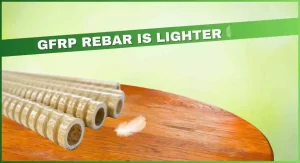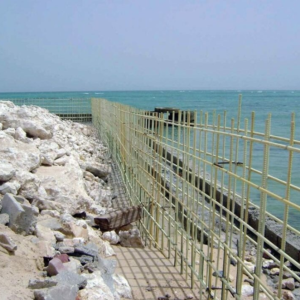When it comes to building the structures that shape our world—bridges, highways, skyscrapers—the materials we choose are more than just building blocks; they determine the longevity, safety, and cost of the entire project. For decades, steel rebar has been the backbone of reinforced concrete. But what if there was a better, more economical solution? Enter Glass Fiber Reinforced Polymer (GFRP). This innovative material is poised to revolutionize the construction industry by offering not just strength but also significant cost savings. Let’s explore why GFRP is the future of construction.
Steel Rebar vs. GFRP: Understanding the Basics

- Steel Rebar: You’re probably familiar with steel rebar—it’s the go-to reinforcement material for concrete. Steel adds tensile strength, compensating for concrete’s natural weakness in tension. But steel has a serious flaw: it’s susceptible to corrosion. Over time, exposure to moisture, chemicals, or salt can cause steel to rust, weakening the entire structure and leading to expensive repairs.
- GFRP Rebar: Now, imagine a material that offers the same, if not better, tensile strength as steel but without the risk of corrosion. That’s GFRP. Made from glass fibers embedded in a polymer matrix, GFRP is not only resistant to rust but also significantly lighter and easier to work with. It’s like giving your building a suit of armor that never rusts and doesn’t weigh you down.
Installation and Labor Costs: The Immediate Savings

Think about the process of building a bridge or a skyscraper. The materials need to be transported, cut, shaped, and installed—no small feat when you’re dealing with heavy steel rebar.
- Steel Rebar: Steel is heavy—really heavy. Moving it requires heavy machinery, and installing it is labor-intensive, driving up costs.
- GFRP Rebar: GFRP, on the other hand, is approximately 75-80% lighter than steel. Imagine how much easier and faster it is to handle. You don’t need the same level of heavy machinery, and workers can cut and shape it on-site without specialized tools. This reduction in weight translates to lower transportation costs, reduced labor expenses, and overall quicker installation. In the world of construction, time is money, and GFRP saves plenty of both.
Maintenance and Lifecycle Costs: The Long-Term Benefits

Now, let’s fast-forward a few years. Your steel-reinforced structure has been standing strong, but the effects of time and the environment are starting to show.
- Steel Rebar: Corrosion has set in. Repairs are needed, and those repairs aren’t cheap. Steel rebar, while strong, is vulnerable to the elements, especially in harsh environments like coastal areas or regions with heavy road salt use. Each repair not only costs money but also causes downtime, disrupting the functionality of your infrastructure.
- GFRP Rebar: GFRP shines in this scenario. Its natural resistance to corrosion means that it doesn’t degrade in the same way steel does. No rust, no weakening of the structure, just consistent, reliable performance. This durability means fewer repairs over the life of the structure, leading to significant savings. In essence, GFRP rebar isn’t just a material choice; it’s an investment in the future stability and cost-efficiency of your projects.
Economic Advantages of GFRP: Why It Pays Off
- Longevity and Durability: GFRP’s durability is not just about surviving the elements; it’s about thriving in them. Structures reinforced with GFRP enjoy a longer lifespan, reducing the need for frequent repairs and replacements. Over time, these savings add up, making GFRP a more economical choice.
- Reduced Downtime: Every time you close a bridge or building for repairs, it’s not just inconvenient—it’s expensive. GFRP’s superior durability minimizes these disruptions, ensuring continuous operation and further reducing indirect costs associated with maintenance.
- Environmental Impact: Beyond the immediate and long-term financial savings, GFRP is also a greener choice. Its production generates fewer carbon emissions than steel, and its long life means less frequent replacements, which translates to a smaller carbon footprint. In an era where sustainability isn’t just preferred but expected, GFRP aligns with global goals, potentially leading to tax incentives and reduced regulatory compliance costs.
Real-Life Examples: The Proof is in the Results

Let’s take a look at some real-world applications where GFRP has made a significant impact:
- Durability in Harsh Environments: In coastal regions, where saltwater exposure quickly corrodes steel, GFRP-reinforced bridges have shown remarkable durability. The reduced maintenance costs and extended lifespan of these structures speak volumes about GFRP’s resilience.
- Cost Savings in Transportation: In large infrastructure projects, the lightweight nature of GFRP has led to substantial savings. By reducing the need for heavy machinery, these projects not only cut costs but also simplified logistics, leading to faster completion times.
- Extended Lifespan: GFRP’s resistance to environmental degradation means structures last longer—often far longer than those reinforced with steel. This longevity translates to lower lifecycle costs, making GFRP an economical choice in the long run.
Conclusion: The Smart Choice for the Future of Construction
As the construction industry evolves, the materials we use must keep pace. GFRP isn’t just a new option; it’s the smart choice for modern infrastructure. While the initial cost may be higher than steel, the long-term benefits—in terms of reduced maintenance, extended lifespan, and overall cost savings—make it a game-changer.
So, the next time you’re planning a construction project, consider GFRP. It’s not just about building today; it’s about ensuring your structures stand the test of time with minimal costs and maximum efficiency. In a world where economic and environmental sustainability are increasingly intertwined, GFRP offers a solution that benefits both your budget and the planet. The future of construction is here, and it’s stronger, lighter, and more cost-effective than ever before.
